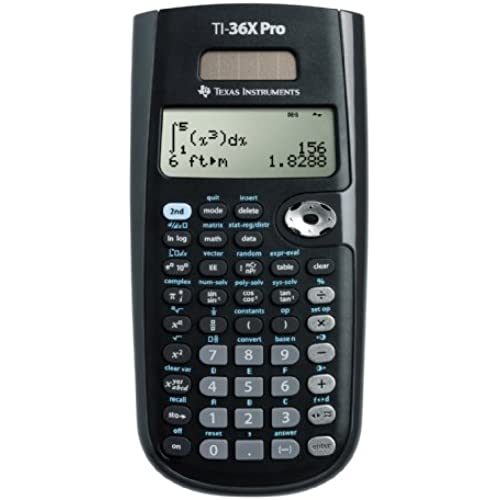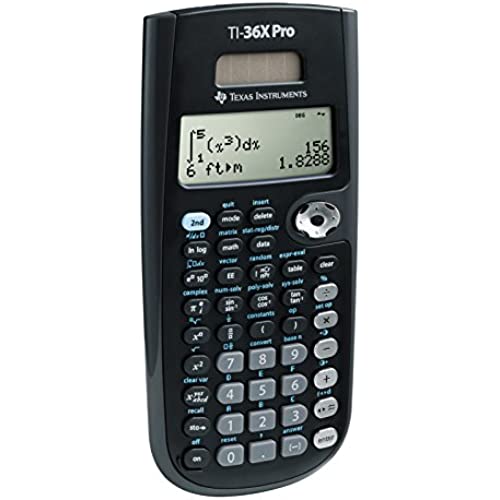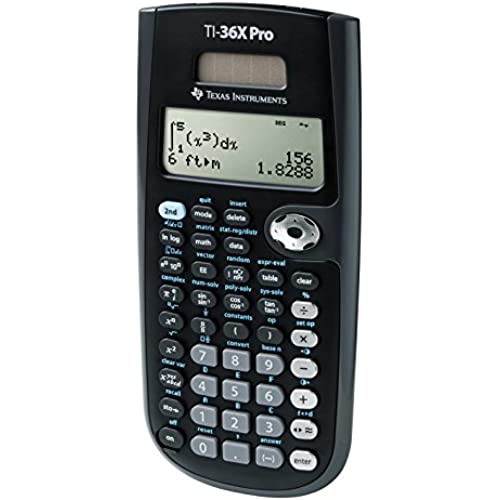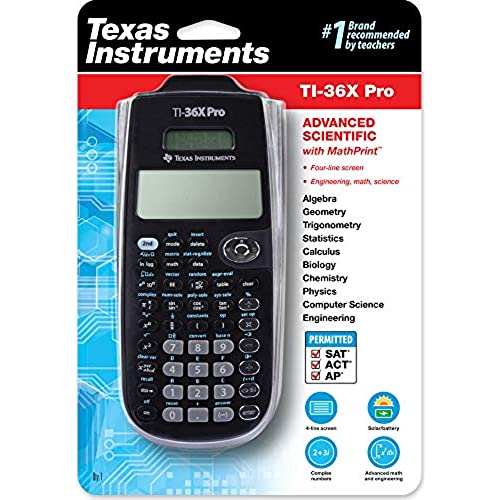







Texas Instruments TI-36X Pro Engineering/Scientific Calculator | 9.7 Inch | Black.
-

Andrew W
> 3 dayI bought this calculator for my upcoming FE Exam in October 2013. I have been using it for the past couple of months to get acquainted and to study. When I was in school I used the TI-89 Titanium religiously. Unfortunately thats not permitted on the FE exam so I chose this one. Upon using it I must say that for a non-graphic calculator its fantastic. The shortcut keys (for exponents, powers of 10, fractions, etc.) are a nice touch. The built in equation solver, polynomial equation solver, system of equation solver certainly shave a lot of time off of my calculations concerning static equilibrium, quadratic equations and circuits. This calculator also does Matrices, up to 3x3 and vectors in three dimensions. It even has popular constants (permittivity, Boltzmann, Ideal Gas, standard atm, etc) built in along with a whole conversion menu. On top of that it does numerical integration and numerical derivatives and plenty of other things Im probably not going to mention. I consider it to be more user friendly than the TI-89 Titanium because of the shortcut keys and nice interface. For example, to calculate a determinant on the TI-89 you must press 2nd, MATH then scroll to Matrix, then select Det( and press enter. Then you have to remember the syntax which is det([a1, a2, a3][b1, b2, b3][c1, c2, c3]) and finally press enter. On the Ti-36X Pro all you have to do is press 2nd, Matrix and scroll to edit and enter how many columns and rows you want in the specified matrix, press enter and then put in your values. Then once the values are saved you go back to the Matrix menu and select Determinant and put in the name of the matrix where you saved the information. Pretty slick for a smaller calculator. The four line display provides enough room to see what your doing and the text is fairly large which I like. With the bigger calculators you usually have to squint to see some numbers, especially in low-light situations. This calculator also features Mathprint. This means that fractions, integrals and most other mathematical notation shows up as its supposed to. However if you dont like this there is a feature to turn it off. This is especially useful for when youre calculating something like a parallel resistance circuit and you want to see that big fraction to make sure you didnt make a mistake. Of course no review is complete without listing the gripes. Theres not too many problems with this calculator however there are something that really bug me. The first one being that there is no option to toggle insert like the TI-89 has. Usually I find myself needed to edit an equation that I just entered. Therefore I have to press second, then insert and put whatever I needed into the equation. Not a big deal but can get annoying at times. Second, I dont like the chrome arithmetic buttons. At times I find myself hitting the subtract button when I wanted to do some addition. However I solved this problem by running a fine-tipped sharpie over the buttons and rubbing off the excess on the surface. Now the symbols have a black color in contrast with the chrome. Much easier to see and I suggest this method if anyone else has this problem. Third, you must press a button multiple times to get what you need. For example say I want to type a complex number (3+5i) on the screen. I press 3, +, 5 and then I have to press the pi, e, i key three times just to get the i symbol. Can be a bit annoying/frustrating and you might make a mistake if youve had way too much caffeine as I normally do. Although I suppose they had to do this to consolidate space in the design process so I can respect that. Just a little annoying but I guess it comes with the territory. This can add a bit of time to the learning curve if youre not used to these multipress buttons. Thats basically it. For a non-graphing calculator I give it a 9/10. Comparing budget calculators, Ive had the TI-30Xa and the Ti-30XIIS before and this one blows them out of the water obviously, hence the name TI-36X PRO. Ive never had a Casio calculator so I cant compare. With this many features and usability at the price of $17 or so its certainly an exemplary buy. A great budget engineering calculator and certainly the best to use on the FE exam in my opinion. Go with this one!
-

Ximena Pena
> 3 dayIt’s a really good calculator. There is certain equations that it can not do. But over all it had most of the functions and keys you need
-

EdO
> 3 dayI had to buy one of these for the FE Exam. As a lifelong TI-84 user there are some quirks, but I felt right at home and after a week using this calculator was second nature. Its reliable, relatively cheap, and full featured. My only request would be a higher resolution screen. The European version of this calculator has a higher res screen and its so much easier to read.
-

Prof. Adolfo Lubowitz DVM
Greater than one weekI own a TI-Nspire CX graphing calculator, but was looking for something a tad more simplistic for my physics 2 course. This calculator has been amazing for me. I am able to compute the different formulas for my class. The buttons are larger compared to my other calculator and I don’t have to worry about finding a cord to charge it. Overall, this TI-36X Pro is a very good calculator.
-

Tim Hubbard
> 3 dayI love this calculator. I grew up with a TI-83 Plus and believe the TI-36x Pro is the best one for the FE Exam. I tried the Casio fx-115ES Plus for 9 months, per the advice of an excellent prof (mechanical and civil background), and while it has certain advantages I find the 4 line display on the TI-36x Pro alone is reason enough to use it instead. I can complete complex problems more efficiently and with less errors than with the Casio - it is easier to backtrack, check what was entered before, and select equations/numbers from previous lines to be carried into new calculations. With the Casio I would often accidentally clear the screen with the on button, out of habit, which deletes the previous entries from memory; even when this was not the case I found it difficult (impossible?) to paste prior entries into current calculations. Also, the Casios list of less-common scientific constants must be referenced to a numerical list of symbols (no names given) on the cover, while the TI-36x Pro lists constants with symbols/names spelled out in the menu itself - much more convenient. This calculator can accept up to 3x3 matrices and can solve systems of linear equations with three unknowns using the entry [A]^(-1)[B]. The way it handles complex numbers is also very convenient, allowing for easy conversion between rectangular and polar form. The only major downside Ive discovered so far is, in matrix mode, the TI-36x Pro cannot accept imaginary numbers as inputs. This is true of many other calculators as well (including the Casio fx-115ES Plus). Its problematic when analyzing AC electrical circuits using mesh (KVL) or nodal analysis (KCL). [Update: The TI-89 Titanium can handle these complex systems with cSolve (but is not FE approved).] One annoying aspect: there is only one button for storing answers as variables, so if you want your entry to be stored as anything other than x, you have to press the variable button repeatedly until the desired letter shows up (for example, for b, you have to press the button 6 times, which cycles x > y > z > t > a > b). [Update: Discovered 2nd -> Recall lists all variables - much faster for recalling them than cycling is. As far as I can tell, however, first-time storage (###->var) does require cycling as stated above.] This is only a minor qualm though; the overall benefits of this calculator easily outweigh the few negative aspects.
-

Phil
> 3 dayIm a university junior computer science major. My workload is extremely math heavy. Almost four years ago when I started at community college, I knew nothing about advanced math, or calculators. I bought the cheapest calculator at Walmart which indicated that it was allowed for use on college tests, (SAT, ACT, etc.). I believe it was the Casio fx-115ES PLUS. Not a bad calculator, and comparable to this one, but it has many shortcomings IMO. A year or so later, by the time I started taking calculus classes I bought a graphing calculator, (ti-nSpire). I really enjoy that calculator too. I was turned onto the ti-36x pro by a professor I had a couple years ago. Since it basically fills the same niche has the Casio that I already have I never saw any reason to buy it. Besides, for the past few years Ive mostly relied on the nSpire. This Fall I began taking physics classes for some of my major requirements. The teacher doesnt allow the nSpire, or any CAS calculator on the tests. I like to use the same calculator in the coursework/homework that Ill be using on future tests, just to have that muscle memory when its showtime. I pulled out the old Casio and dusted it off, and after the past few years with the ti-nSpire, lets just say I was less than inspired by using the Casio. The biggest thing that I dislike about the Casio is that you can only see the present problem that youre working on at any given time. I got used to being able to scroll up and see previous problems/solutions, and being able to navigate the cursor up to a previous solution, press enter, and have it inserted into another equation, or whatever that Im currently working on. Hopefully that makes sense. In any event, the ti-36x pro does this too! You can see the three most recent problems that you last worked on, in addition to the one youre currently working on. And you can scroll back to any spot in the history, up until the point where you last cleared it. You can also easily insert solutions, or portions of previous problems into the current. For me this is crucial during test taking. It is the best type of calculator work flow for myself, and although something similar to this can be achieved with the Casio, I was never able to get it to work with out feeling cumbersome. There are several other things that I like about this calculator over the Casio as well. In some aspects I like it even more than the ti-nSpire. Mostly just because using this calculator is so smooth and simple. If I dont need to take limits, anti-derivatives, or indefinite integrals, or plot actual graphs, I would choose the ti 36x pro over the nSpire, just because it is so simple and elegant to use. Ive not used a ti-84 much. Never owned one, but have played with them a few times. As far as I can tell, this thing is basically a ti-84, without graphing capabilities. In short, if you need a calculator for algebra, engineering, physics, trig, some calculus, etc., but you cant use a full fledged CAS, or even a regular graphing calculator, this is the best option.
-

Abigail
> 3 dayClassic TI calculator. Does the job.
-

Anthony Richardson
> 3 dayThis calculator has complex number support (rectangular and polar form) and is usually sufficient for DC and AC circuit analysis. It has real matrix support but not complex matrix support so it can be used to solve systems of equations in mesh and nodal analysis in DC circuits but not AC circuits. In my experience most faculty dont require a calculator that can solve complex matrices in AC circuits.
-

Speakingstraightfacts
> 3 dayIt worked well for me some keys you gotta ask the teacher about
-

Josh Olson
> 3 dayIve owned everything from a free calculator that doubles as a pencil case to the TI-NSpire CX CAS with a color display. Aside from graphing, of course, this 36X does EVERYTHING better than any other calculator Ive used. The interface is incredible (fraction bars, scroll and multiple line functionality), it handles complex numbers like a champ, basic equation solving, even derivatives and integrals? So small but SO powerful. Just buy one.
